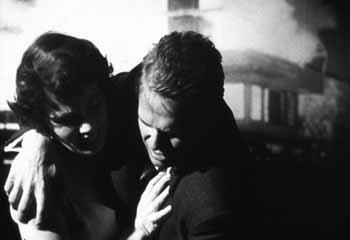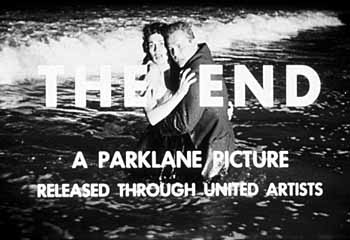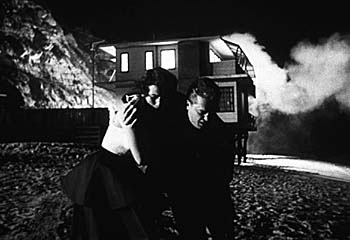|

Still #2: Mike and Velda from the restored footage.
More coherent, less cosmic
What real difference does the "new" ending make? Again, a tradeoff. The stark bluntness of the old ending appeals to modern filmmakers such as Alex Cox and Quentin Tarantino, who were clearly attracted to the nervous purity and implied armageddon of Adrich's violent statement. Now, with the new ending restored, this anarchic edge is softened, but what has been reinstated in its place is the screenwriter's critical emphasis on the Mike Hammer character.

Still #3: Mike and Velda from the restored footage.
Bezzerides has been overturning Spillane's conventions throughout the film, by substituting avarice for the original Hammer's vigilante code, moronic ignorance for the original's craftiness. But his key inversion is saved for the finale. In the novel Hammer finally catches up with femme fatale Lily Carver just after she's taken an alcohol rubdown. He offhandedly ignites her with a Zippo. She burns in agony. He takes calm satisfaction from his deed. It's sort of a followup to outdo the sadistic I the Jury ending. There Hammer shoots a wrong dame in the stomach with the quip, "It was easy".
Pulp into Poetry
By neatly turning the burning alcohol gimmick of the novel into a fantastic atomic pyre, Bezzerides elevates Kiss Me Deadly to a mythical plane, complete with Dr. Soberin's classical allusions. The clever and ironic difference is that Hammer can't take pleasure from Carver's fate—because he's already lying on the floor, shot by Carver with just the offhand sadism that's supposed to be his own trademark! Hammer is last heard, not coining nasty misogynist quips, but crying for Velda like a wailing mama's boy. Never has an iconographic American hero character been subjected to such a deflation. In Kiss Me Deadly it's the Atomic Genie, freed at last, that declares itself The Jury and executioner and burns the universe to cinders. This is the restored ending's real change to Aldrich's film. By dwelling on Hammer's powerlessness against the fiery evil he has released, the film's original final statement now firmly reinforces Bezzerides' condemnation of the whole Spillane ethos and what it says about American arrogance and greed.
Why did they cut it?
Accounting for the short ending, with its editorial crudity and truncated music track, is something of a guessing game. Kiss Me Deadly was subjected to a troubled release in 1955 because of nagging local censorship problems. The Kefauver Congressional Commission of that year set Kiss Me Deadly aside for special condemnation as an example of immoral entertainment responsible for juvenile delinquency, and Aldrich felt it necessary to conduct a writing campaign for the free speech rights of independent producers. Was the short ending some kind of censor's cut? This doesn't seem likely, unless some rural censor liked the idea of implying that Hammer burns alive to pay for his Breen Code misdeeds. If it was, it's the sloppiest censor chop job on record. Not even United Artists, friend of the independent producer, ever released a film with a soundtrack hacked off as badly as this one.
While emphasizing that I can't be sure even now, I think the explanation for Kiss Me Deadly's garbled ending wasn't censorship, but something far less glamorous—an accident in film handling. What most likely happened is that sometime after Kiss Me Deadly's theatrical release, a film handler accidentally chewed up the last reel's original negative, perhaps while rewinding it. A quick fix was concocted to cover this error: cobble together some shots with a cheap end title optical, cut the soundtrack to match, put it back in the can and act like nothing ever happened. Any editor can vouch for this kind of activity from, ahem, personal experience. This is the only scenario I can come up with which would account for all of the facts. It is probably correct. Kiss Me Deadly, our radical film school monument, was never quite so radical as we thought.

Still #4: Mike and Velda from the restored footage.
MGM Home Video has planned a video reissue for August 1997. This "restored original" version will retain the familiar truncated ending as an added item, for purposes of comparison. Interest is expected to be high. Probably the film noir most discussed in print, Kiss Me Deadly will finally be available to be viewed and studied in its correct and original form. Readers are urged to reference Alain Silver's perceptive writings on Kiss Me Deadly in his and James Ursini's Film Noir Reader, as well as the original, restoration-inspiring article here in Images (issue #2/November 1996). Perhaps the present article will become obsolete if some retired executive or lab technician comes forward to clear up the details of the Mike Hammer Mangled Movie Mystery. For now, the satisfaction of putting this truly important film back together will have to do.
Update: go to our review of the MGM Home Video release of the restored Kiss Me Deadly (from issue #4 of Images).
page 2 of 2

©1997 Glenn Erickson
Glenn Erickson is a video editor in home video advertising. In May, his video & film facts column "MGM Video Savant" will go online on the MGM Lion's Den Web Page: www.mgm.com/mgmhv.
Photo credits: MGM/UA. All rights reserved.
|






